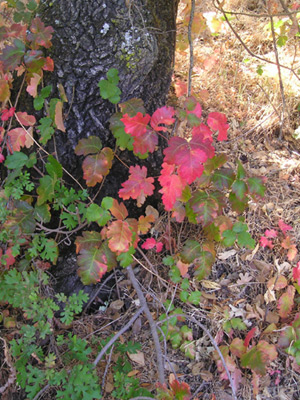- Toxicodendron diversilobum
taxobox
name = "Toxicodendron diversilobum"
image_caption = Western Poison-oak (larger leaves; small leaves are another plant) at base of oak tree
status = secure
regnum =Plantae
unranked_divisio =Angiosperms
unranked_classis =Eudicots
unranked_ordo =Rosids
ordo =Sapindales
familia =Anacardiaceae
genus = "Toxicodendron "
species = "T. diversilobum"
binomial = "Toxicodendron diversilobum"
binomial_authority = (Torr. & A.Gray) Greene|"Toxicodendron diversilobum" (syn. "Rhus diversiloba"; Western Poison-oak or Pacific Poison-oak) is a plant best known for its ability to cause allergic rashes after contact. Western Poison-oak is found only on the Pacific Coast of the
United States and ofCanada . It is extremely common in that region, where it is the predominant species of the genus; the closely relatedAtlantic Poison-oak ("T. pubescens") occurs on the Atlantic Coast. The hyphenated form "Poison-oak" is used, rather than "Poison Oak" to clearly indicate that it is not a variety ofoak , just as "Poison-ivy " is not a variety ofivy .Appearance
Western Poison-oak is extremely variable in growth habit and leaf appearance. It grows as a dense
shrub in open sunlight, or as a climbingvine in shaded areas. LikePoison ivy , it reproduces by creepingrootstocks or by seeds. The leaves are divided into 3leaflets , 3½ to 10 centimeters long, with scalloped, toothed, or lobed edges- generally resembling the leaves of a true oak, though the Western Poison-oak leaves will tend to be more glossy. Leaves are generally bright green in the spring (or bronze when first unfolding), yellow-green to reddish in the summer, and bright red or pink in the fall. White flowers form in the spring and, if fertilized, develop into greenish- white or tan berries. "Toxicodendron diversilobum" is winterdeciduous , so that after cold weather sets in the stems are leafless and bear only the occasional cluster of berries. Without leaves, poison oak stems may sometimes be identified by occasional black marks where sap may have oozed and dried.Botanist John Howell observed that "Toxicodendron diversilobum"'s toxicity obscures its merits. "In spring the ivory flowers bloom on the sunny hill or in sheltered glade, in summer its fine green leaves contrast refreshingly with dried and tawny grassland, in autumn its colors flame more brilliantly than in any other native, but one great fault, its poisonous juice, nullifies its every other virtue and renders this beautiful shrub the most disparaged of all within our region." [cite book | last = Howell | first = John Thomas | authorlink = | coauthors = Frank Almeda, Wilma Follette, Catherine Best | title = Marin Flora | publisher = California Academy of Sciences; California Native Plant Society | date = 2007 | location = | pages = p.264 | url = | doi = | id = | isbn = ]
Habitat
Western Poison-oak is found only on the Pacific Coast, where it is common, and ranges from Southern Canada to the
Baja California peninsula . It is one of California's most prevalent woody shrubs but also climbs, vine-like, up the sides of trees, and can be found growing as single stems in grassland--often as part of early stage succession where woodland has been removed, and serving as a nurse plant for other species. The plant is often found in oak woodlands andDouglas-fir ("Pseudotsuga") forests. Along the Avenue of the Giants in northern California, the vine form may be seen climbing many feet up the trunks of Coast Redwoods (Sequoia sempervirens). It can also be found in damp, shady areas near running water and out of direct sunlight. Any trail leading to a waterfall on California's coast will most likely be home to western poison-oak. Western poison-oak can also be found in some inland mountain ranges such as the Cascades.Toxin
Western Poison-oak leaves and twigs have a surface oil,
urushiol , which causes an allergic reaction. Around 15% [ [http://science.howstuffworks.com/poison-ivy.htm Howstuffworks "How Poison Ivy Works" ] ] to 30% [ [http://mic-ro.com/plants/ Contact-Poisonous Plants of the World ] ] of people have no allergic response, but most if not all will become sensitized over time with repeated or more concentrated exposure to urushiol.ee also
*
Toxicodendron
*Urushiol
*Poison-ivy
*Poison sumac References
External links
* [http://www.aad.org/public/Publications/pamphlets/Poison_IvyOakSumac.htm American Academy of Dermatology - Poison Oak info]
* [http://www.pesgce.com/toxicodendrondermatitis/derm.asp Toxicodendron Dermatitis: Identification, Immunologic Mechanisms, Diagnosis, and Treatment]
* [http://www.hanskellner.com/photos/2004/05/PoisonOak/ Western Poison-Oak Photo Gallery]
* [http://www.hanskellner.com/archives/2003/04/25/poison_oak_treatment_zanfel_ingredients.html Zanfel Ingredients (Poison-oak, ivy, sumac treatment)]
* [http://trailmix.net/files/folders/tips/entry94.aspx Trailmix.Net Free E-Learning Course: Identifying and Avoiding Poison Oak]
Wikimedia Foundation. 2010.
